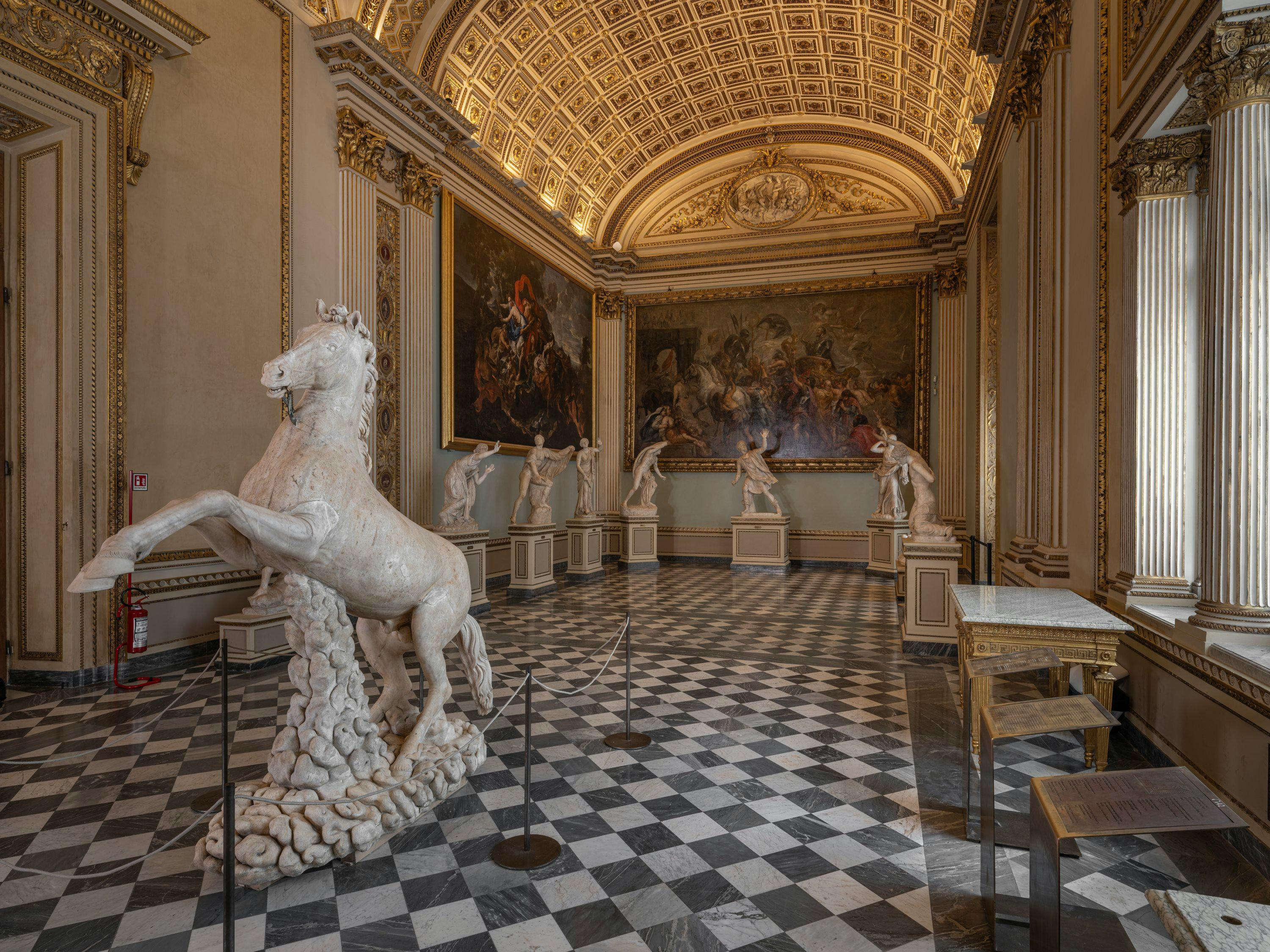Prancing Horse or Buontalenti Horse
Roman art
The statue depicts a life-size horse rearing up on its hind legs.
The work is preserved in the Uffizi Galleries and has a rather complex history, which is closely linked to that of the Niobids group. It was found in 1574 at the mouth of the Tiber, not far from the ancient city of Portus. As early as 1588, it was placed in the Garden of Villa Medici in Rome together with the famous sculptural group, which had been discovered in 1583 in the vineyard belonging to Gabriele and Tomaso Tommasini, located a short distance from the Basilica of St. John Lateran in Rome. The association of the horse with the Niobids originates from what Ovid wrote in the Metamorphoses about this tragic myth: the male children of Niobe, the wife of Amphion, the king of Thebes, were guilty of having insulted Latona, and for this reason they were shot by the arrows of Apollo, son of the goddess, while they were riding a horse (Ov. Met. 6, 218 - 239). However, given the presence in the collection of Ferdinando de' Medici (1549 - 1609) of a second horse sculpture in marble, which unfortunately has been lost, it is not easy to retrace the history of the Florentine statue.
In 1625, the horse was displayed among the Niobids in Giacomo Lauro's depiction of Villa Medici (Lauro 1628, fig. 162), as confirmed by the Inventory of Palazzo della Trinità de' Monti made by Pietro Lavoratorini in 1680. In 1761, the sculpture was moved from the garden to the Gallery of Villa Medici for some restoration works; while in 1770, after the spoliation of the estate at the behest of Grand Duke Peter Leopold (1747 - 1792), it was moved to the “Stanzone” of the Pitti Palace, together with part of the Niobids, to be restored once again. After this restoration, all the statues became part of the Uffizi collections, but Luigi Lanzi, an assistant to the director Giuseppe Pelli Bencivenni (in charge from 1775 to 1793), deemed the horse to be irrelevant to the cycle of the Niobids, so he separated it from the group and displayed it in the First Corridor, probably to counterbalance the imposing group of Hercules and Nessus. After remaining in the Corridor until 1798, the horse was first moved to the Vestibule together with other animal statues, to be finally reunited with the Niobids in the early 20th century in the room dedicated to them, where it was displayed until 2006 in front of the Medici Vase. Then, after being exhibited for about a decade in the Buontalenti Hall, the sculpture was temporarily moved to the premises of the Pitti Palace, and is now back in the Niobe Hall.
The pose we can admire today, with the horse rearing up, is the result of several restoration works dating back to the end of the 16th century: the muscles of the chest and the position of the reins, which are depicted along the side of the animal, suggest that originally the horse was walking. In all likelihood, this choice was influenced by a comparison with the horse depicted on the main side of the sarcophagus decorated with the theme of the Massacre of the Niobids, which at the time was preserved in Villa Borghese in Rome (now in the National Archaeological Museum of Venice, inv. 24). Moreover, the absence of holes for any additional marble or bronze elements (such as collar or breastplate) rule out the possibility that the statue represented a draft horse, while it is more likely - thanks to comparisons with other works - that the animal was accompanied by the statue of a figure on foot, presumably a victorious charioteer.
Finally, as far as dating is concerned, the style was influenced by the late classical tradition; however, it is precisely the diffusion and success of this iconographic type, as well as the prolonged time spent underwater and the sanding it underwent in the post-antique period, that do not allow to find a precise chronological context for this sculpture. In any case, based on the drill and chisel work on the mane, it can be assumed that the statue dates to a period between the late Augustan and early Antonine ages.
Modello 3D realizzato in collaborazione con Indiana University, Politecnico di Milano e Università di Firenze
http://www.digitalsculpture.org/florence/main/model/5cff8a0cb18d4c59b56a48469c0dfab7
G. A. Mansuelli, Galleria degli Uffizi. Le Sculture 1, p. 126, Roma, 1958; A. Cecchi, C. Gasparri, La Villa Médicis. Le collezioni del cardinale Ferdinando. I dipinti e le sculture 4, p. 326 n. 597, Roma, 2009;L. Camin, “Trovato in altro tempo ed in altro luogo”. La grande statua di cavallo delle Gallerie degli Uffizi in "Un'anima grande e posata" Studi in memoria di Vincenzo Saladino offerti dai suoi allievi, a cura di E. Bazzecchi, C. Parigi, pp. 21 – 33, Scienze e Lettere, Roma 2018; L. Camin in ‘A cavallo del tempo. L’arte di cavalcare dall’Antichità al Medioevo, catalogo della mostra (Firenze, Gallerie degli uffizi, Giardino di Boboli, Limonaia 26 giugno – 14 ottobre 2018) a cura di Lorenza Camin, Fabrizio Paolucci, Livorno 2018, pp, 318--320
